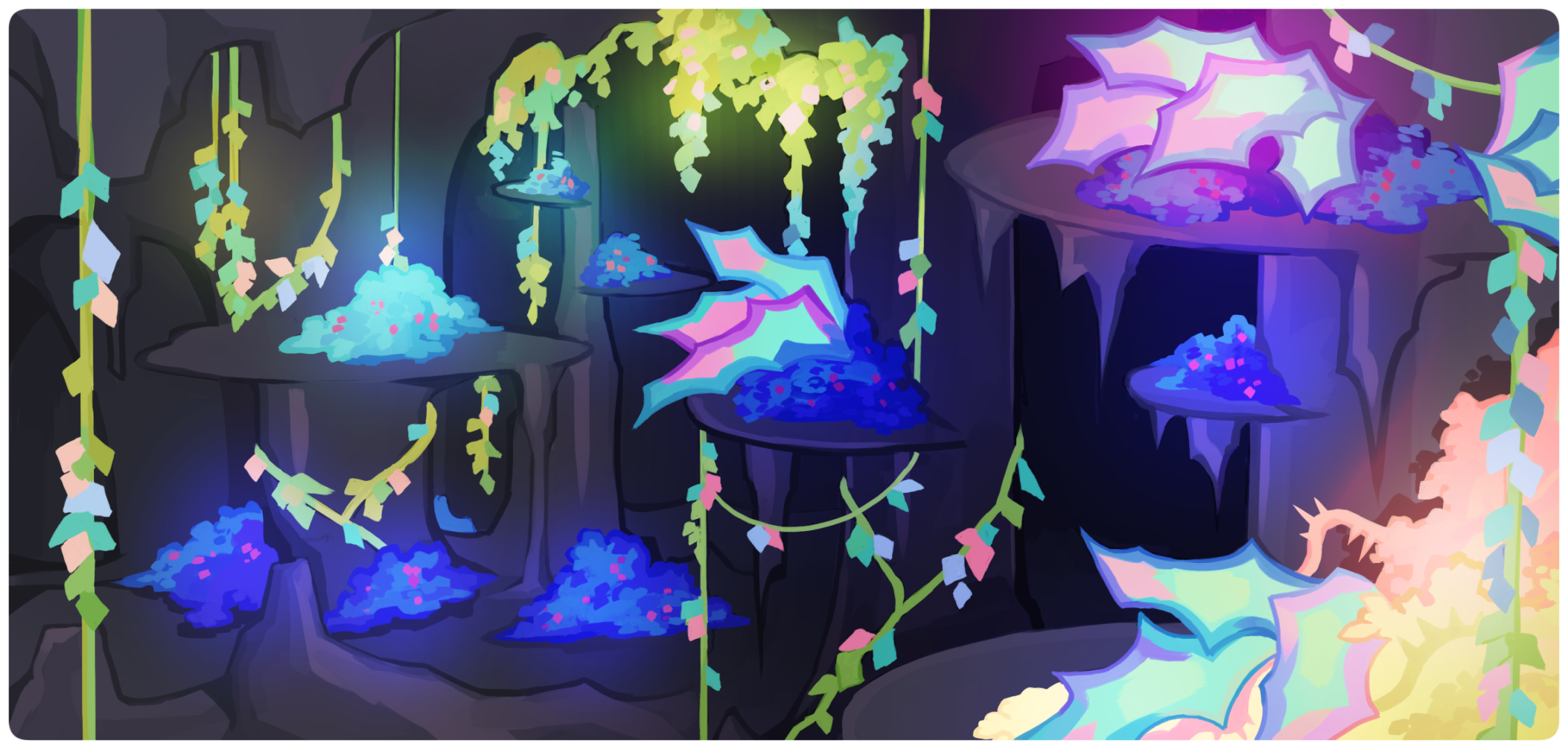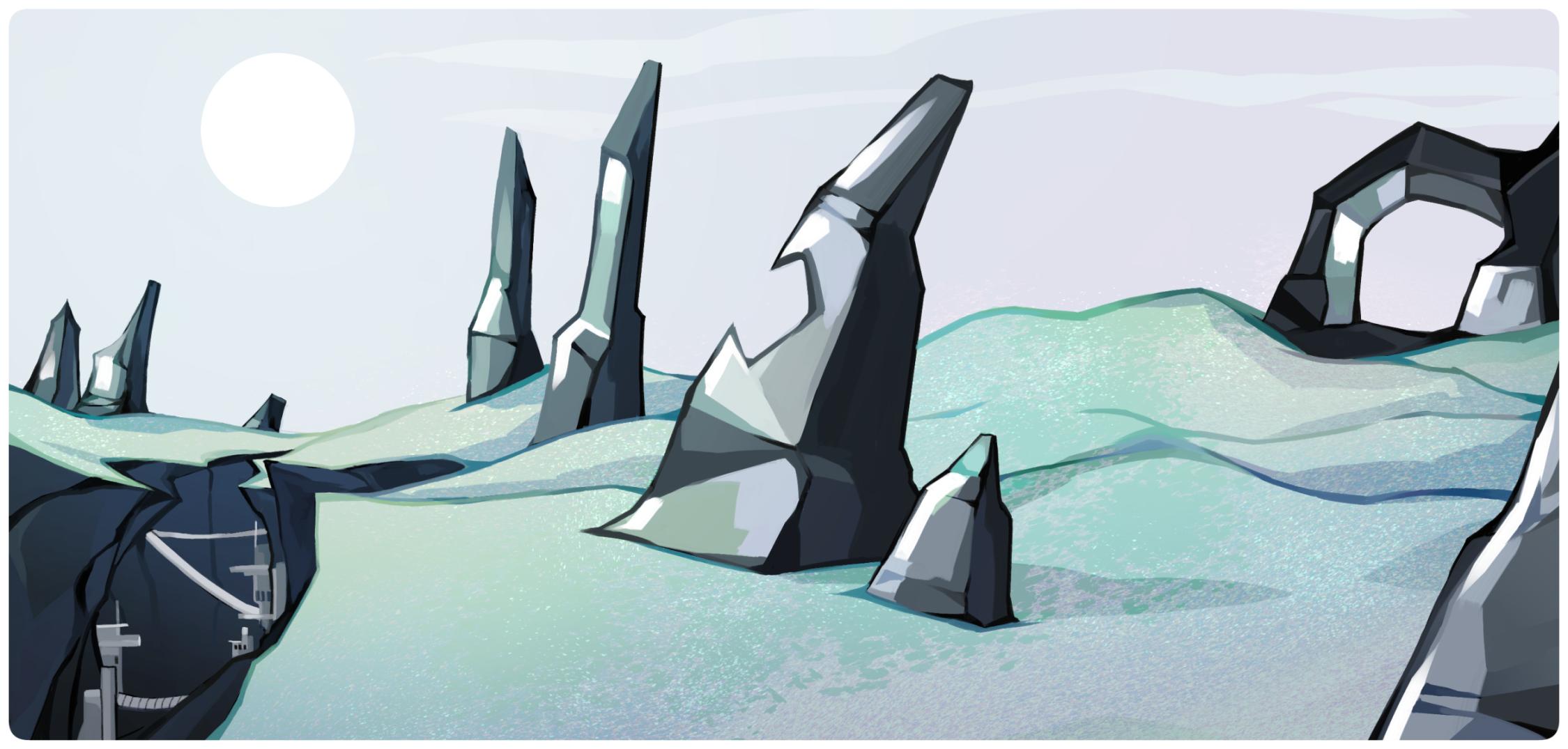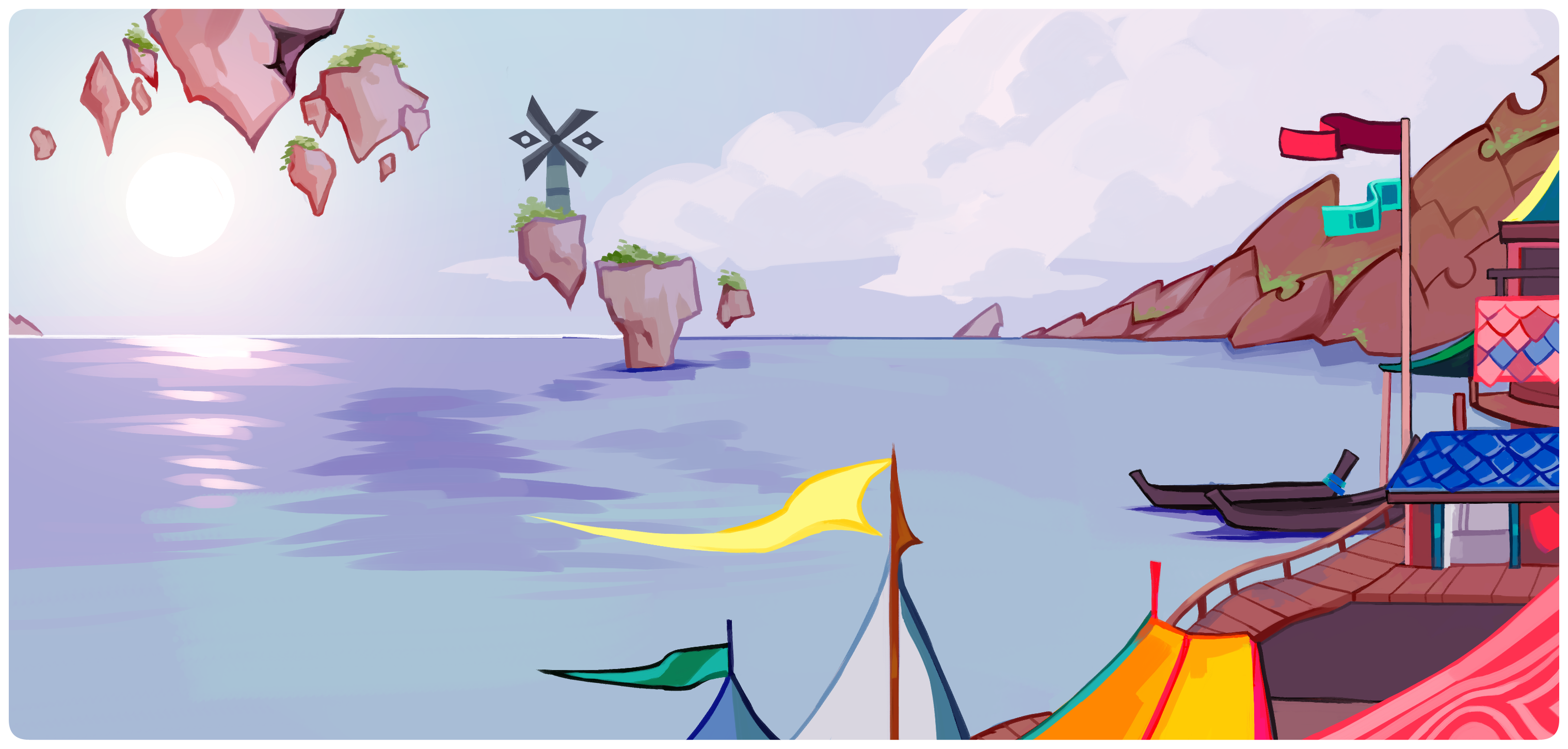Locations
There are countless locations and biomes around Skire. Many are classified by the type of important crafting materials that can be found there. More biomes will be added over time!
MAGIC
Undercliffs
UNDERCLIFFS

The undercliffs are an area deep beneath the shelf-like mountains and cliffs that extend from Meteor Lake. Due to the impact of the meteor, large, flat rocks poured over the edge of the impact site behind the mountains, leaving beneath them a vast series of immense caves. The sheets of rock extend for miles in all directions, and blanket the entirety of the cave system in darkness, leaving only the edges lit barely by sunlight. Plant life within provides the only natural source of light within the caves.
The rocks within these caves are bizarre stalagmites and stalactites that formed large, flat discs of stone ringed around the large stone pillars. These plates of rock can be quite massive, often separating layers of the cave. They are large enough to traverse across with ease, and host numerous species of plant life. These cultures of life often differ vastly from one another, separated by the sheer size of the caves and the plates that split them apart.
Habitability:
Long term living is not common here. Typically, spelunkers and people on expeditions can be found here. It is quite easy to get lost.
Flora/Fauna:
Most all plants in the Undercliffs will give off subtle glow that provide enough light to traverse the deeper one may get into the undercliffs. It becomes almost pitch black into the deepest crevices of the rock formations, but the deeper one goes the more plants one may find who thrive in this sense of moist darkness. The flooring of these caves are often littered with strange plant life that many say seem alive in the way that they creep up the rock formations. This dense blanketing makes it easier for explorers to use the stone plates to traverse.
Large serpents weave beneath the massive pillars of stone, the largest predators. Creatures with webbed wings inhabit the dark recesses, feeding mainly on fruits and cave insects. There is a wide variety of different creatures, many that live off either minerals or natural predation. Large pack beasts also roam the different levels, noted often by the thumping sounds they make while moving. Most species have adapted sound and scent based ways of traversing the caves and locating food.
Culture:
Due to any lack of permanent settlements, it is most common to find adventurers in the Undercliffs, camping on their own, or with smaller expedition parties. It is commonplace to utilize drop boxes, small containers littered about the caves where explorers can leave resources for others. Those in the Undercliffs tend to work together silently, leaving any leftover or extra gear to help another exploring the recesses. Food is strictly kept out of these boxes to prevent destruction by local Fauna.
Climate:
Humidity is near constant in the Undercliffs. Adventurers tell time by the temperature and level of humidity, the Undercliffs colder at night, and more humid during the daytime on the surface. In certain seasons it can get quite hot beneath the stone.
Key Locations:
There are no key locations. There may be larger encampments outside of the Undercliffs for preparation, but otherwise there are no permanent settlements.
MAGITECH
Glass Desert
GLASS DESERT

The Glass Desert is a place where the sand has mixtures of tiny glass shards mixed in with it, causing the sands to glitter and practically reflect the world above. The origin of this glass is extraterrestrial, as these tiny particles are the shaved off from large asteroid debris that landed here and remained mostly intact, while also collecting the debris from most of the other edges of Skire. There are differently sized pillars of asteroid littered about the Glass Desert, often with shaved-flat sides from harsh winds carrying the sands and glass particles. The strength and number of these particles have whittled away at the fallen meteors and created reflective mirrors from these rocks. There is very little on the surface of this area outside of a canyon that hosts the majority of those that inhabit this harsh area, centralized in a city called Ravim. This canyon has stores wall to wall with bridges and other walkways that connect the areas. This is the main hub of the Glass Desert and it is a massively renowned trade center for rare goods specifically.
Habitability:
Living on the surface of the Glass Desert is nearly impossible. Sandstorms are likely to destroy anything built here. During these sandstorms, the air is filled with glass shards that can tear most anyone apart without proper protection. The most habitable zone is within Ravim, the large canyon settlement protected between the rocks.
Flora/Fauna:
Very little lives on the surface of the Glass Desert. There are often secondary biomes far beneath the surface, accessible by the large canyons, that shield them from the inhospitable sands above. Beneath the surface exists still-water caverns, their ceilings coated in mosses that collect the small bits of groundwater and rain that rarely seep through. Plants here are desperate to collect the moisture that makes its way here, rooting themselves in the still water and often recycling it to keep it clean. Plants here are greyish blue or silver in color.
The majority of fauna that exists here also exists underground, dwelling in the still water. These creatures are generally small, but in the more expansive caverns, larger creatures may exist. Large, armored beasts are the one thing often found on the surface. They are largely sedentary, their source of food generated from sunlight. Their thick hide can resist the harshness of the sandstorms for some time.
Culture:
The center of civilization in the glass desert exists in Ravim. It is incredibly difficult to traverse to this area, and many here consider it a rite of passage to get through the Glass Desert. Making the effort to pass through the desert often means that one wants something very rare or specific, badly enough to risk one's life to find it. It may also denote that one has something of great value or rarity, statuses revered in Ravim. There is very little law here, and the market functions as one of the main hubs for rare and strange artifacts on Skire.
Climate:
Above ground it is incredibly dry and inhospitable. The sand largely keeps the environment dry and devoid of life. Occasional, rare rainstorms hit this area, often seeping through the ground to caves below.
Key Locations:
RAVIM - Ravim is the name of the canyon and the canyon's civilization, and is the only hospitable place in the desert. It hosts a large variety of people, often there to hawk rare wares at a great cost.
MAGITECH
Meteor Lake
METEOR LAKE

Meteor lake is a massive brackish water expanse, hard to often make out one end from the other, leading many to equate it to an ocean in terms of its scale. Certain depths of the lake may have higher levels of salinity than others. The beaches that surround this place are grand, often rocky in nature but mixed with sandy shores. It was formed by the impact of a large Meteor, which many now know as having been a piece of one of Eeredi's moons, Ofae. With it came Nautipods, an aquatic species of humanoids that dwelled deep beneath the surface for many years before emerging. The impact also formed a vast mountain range surrounding the lake, also forming the Undercliffs in the process. There is one major fishing hub "city" that exists on one edge but its more of a comforting, colorful town.
Habitability:
Meteor Lake is mostly inhabited by small fishing towns. Some may also live out on boats. It is a bustling area popular with tourists.
Flora/Fauna:
The mountains surrounding the lake have small pockets of plant life between their scale-like peaks, formed by the impact of the meteor. Most other plantlife is found beneath the water's surface, home to various ocean plants, algaes, and seaweeds. Plants tend to grow on the sheer rock edges of the water.
Fish of countless variety are the most common fauna found in Meteor Lake. Waterbirds also populate the sky.
Culture:
Most inhabitants of Meteor Lake live in small seaside towns. At the main hub, it is commonplace to decorate most buildings with scales from strange fish or serpents that they have proudly caught, and fishing rods and netting are found frequently within the build style of this place. As part of the town's allure, they like to theme their arcitecture and homes with netting holding objects and colorful stones or scales. Some hang lures from their nets as a sign of good luck with catches, or retire tools and objects they have previously used in successfully catching fish, often an offer for someone else to claim the object and test their luck. They have a large section of their boating docks to be specifically for air boats that help those unable to fly get to Stonewing. It's probably for this reason they decorate almost like a tourist attraction...
Climate:
Meteor Lake has a cool breeze quite consistently, and is impacted less so by seasonal changes. It stays somewhat warm all year around, but may get a little chillier in winter months.
Key Locations:
LUELOR - Luelor is the main fishing town of Meteor Lake. It is a hot spot for tourists, but also offers air travel to stonewing for those unable to fly. The town itself is very colorful and vibrant, as well as its people.